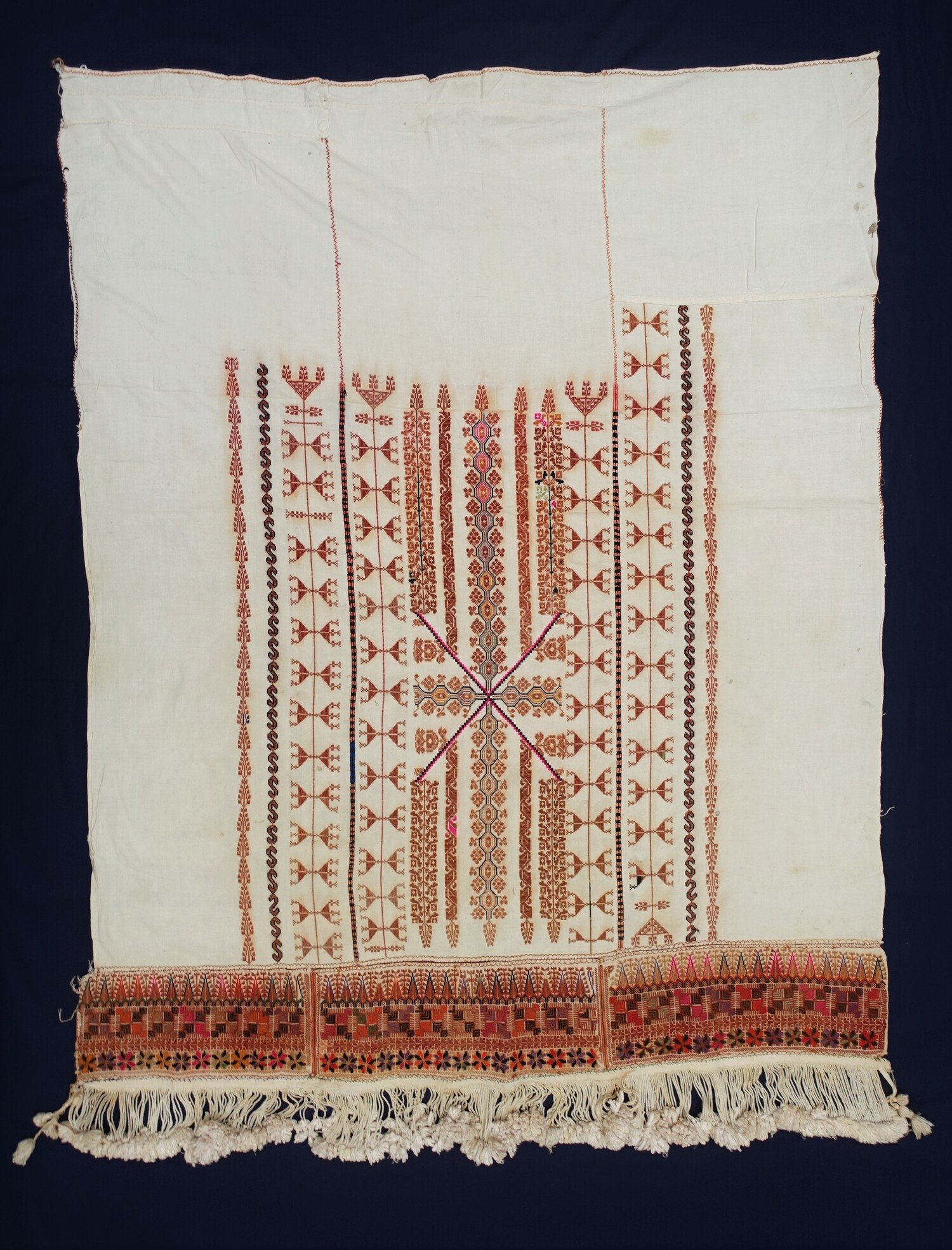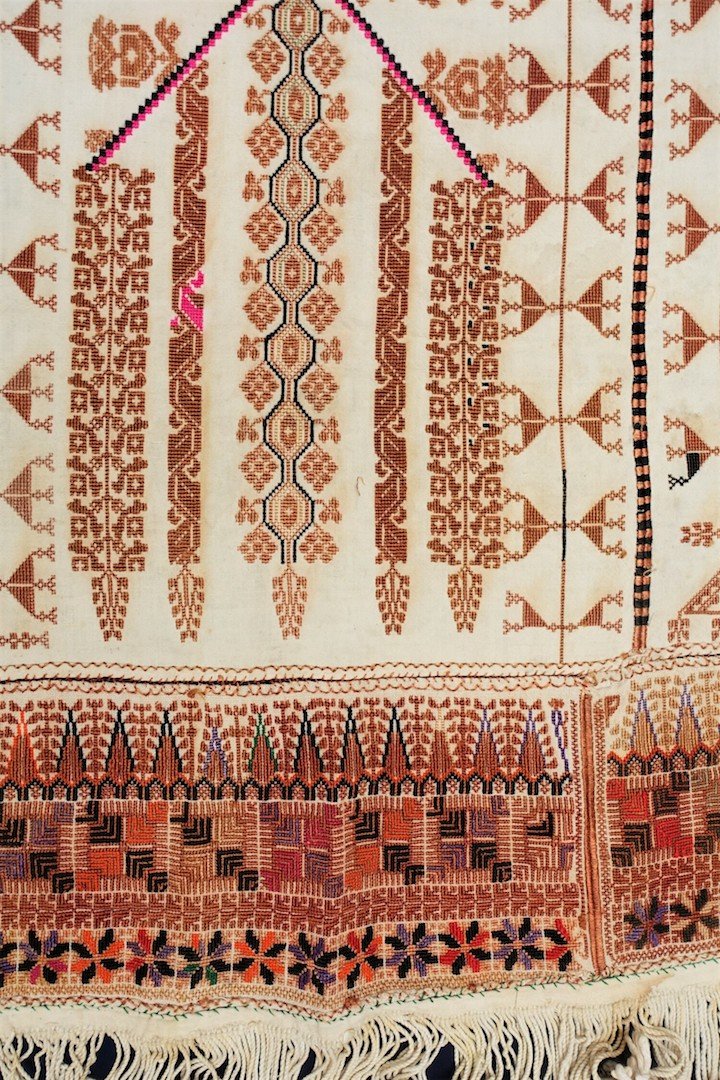The Textile Research Centre (TRC) was opened in 1991 in the centre of historic Leiden, The Netherlands and is led by Dr. Gillian Vogelsang-Eastwood. The TRC collection of textiles, garments and accessories includes items from all over the world, literally from the Andes, via Zanzibar, to Japan — including Palestine. The collection now includes more than 34,000 items and is still rapidly growing. The objects are used for research, teaching, exhibitions and publications. The catalogue is published on line, with photographs and a brief description of all the items. These items are open access.
Last month. Dr. Gillian Vogelsang-Eastwood contacted me to collaborate on an article that showcased a beautiful, newly donated ghudfeh scarf from al-Khalil. I was very proud to collaborate with her on this article, and was invited to author more for The TRC’s website in the coming year. The distinguished research Dr. Gillian has provided our community on Syrian and Palestinian textile traditions have guided my interests and career for many years, and it is with great joy that I share the article below. Learn more about The TRC’s work and their expansive online collection at the links below. You may also find her publications on the resource list here.
Partial Palestinian shawl from Hebron, c. 1900 (TRC 2023.0064).
Among the textiles and garments recently donated to the TRC Leiden by the Dool family, Dordrecht, is an embroidered cloth (obviously damaged) that has since been identified as part of a Palestinian embroidered shawl (TRC 2023.0064). More specifically it is very likely that it comes from Hebron, in what is now the southern West Bank and about 19 km south of Jerusalem. In the Hebron region such a shawl is called a ghudfeh. Furthermore, the piece appears to date to c. 1900. But how did we come to these conclusions? In other words, what did the embroidery tell us?
There are various clues:
The ground cloth is hand woven and is made up of three lengths of cloth that are each about 36 cm in width and have slightly ‘wobbly’ selvedges (not the 'perfect' selvedges associated with machine made cloth). The width of the cloth is an indication that the cloth was probably woven on a horizontal loom (normal for the Levant) worked by one person. Such a three-piece shawl is common for Hebron shawls. The Hebron element is also suggested by the type of fringing at one of the transverse ends.
The material for the ground cloth is cotton, rather than linen. Cotton was being introduced in Palestine from the late 19th century. The cotton probably came from either India or more likely Egypt.
The thread used for the embroidery is made of floss silk, which is an unspun silk form. In the early 20th century Palestine there was a move from floss silk to spun silk forms. By the 1920s another significant change took place when mercerised, spun cotton threads, especially those produced by the French firm of DMC, became more widely available and used. These were both cheaper and easier to use than floss silk forms. The type of thread would therefore suggest a date for the cloth prior to the early 20th century, and a date from the late 19th century on the basis of the type of cloth.
Detail of a Palestinian shawl from Hebron, c. 1900 (TRC 2023.0064).It may be added in this context that most of the embroidery yarns at this time in the Levant came from Syria, especially from the Aleppo region, which had a long history of silk cultivation and the production of silk threads and woven cloth. Alas, this historic industry has been destroyed by the civil war that has plagued this region in recent years.
Detail of a Palestinian shawl from Hebron, c. 1900 (TRC 2023.0064).
The embroidery silks of the cloth under discussion were dyed with natural dyes, especially the dark blue (probably indigo) and a brick red (possibly either madder or pomegranate, but these identifications need to be confirmed). However, some bright pink silk threads were also used and this colour is associated with aniline dyes, a form of European artificial dye matter that became popular at the end of the 19th century. Often the early examples of aniline dyes were not colourfast and used to bleed when the textile was washed. In the shawl these threads show some bleeding.
Then we come to the stitches. Early to mid-19th century Palestinian embroideries tend to be made with a range of stitches including back stitch, cross stitch, satin stitch, stem stitch, trammed tent stitch, as well as couching. From the 1870s onwards European and American Christian missionaries introduced embroideries in their schools and ateliers that were only worked with cross stitch.
By the end of the 19th century cross stitch had as a result become the most widely used stitch for the production of embroidery for Palestinian dresses, shawls, headdresses, etc. It appears to have become popular because this stitch was relatively quick to work. The cloth we are discussing has only cross stitches. It is also worth noting that it would appear that all the stitching of the cloth was carried out by one person, as there is no striking difference in how the stitches were worked.
And last, but by no means least, the patterns. The shawl includes a variety of geometric motifs including cyprus trees, S-shapes, a large X-shape, as well as rows of blocks of repeating geometric forms made up of squares, themselves constructed from L-shapes. Such blocks are very characteristic for Hebron embroideries, but the S-shapes are often referred to as typically Ramallah in origin, while the large X-shape in the middle of the cloth is sometimes associated with Qastina in Gaza. This leads to the question: did the maker of the embroidery see items from other parts of Palestine and copied them? Or was the Hebron motif repertoire more diverse than we now appreciate?
Detail of an embroidered woman's dress from Hebron, c. 1920 (TRC 2009.0194). Embroidery includes blocks with geometric motifs, but also cyprus trees and other motifs, all worked in cross stitch.It is also noticeable that one of the long side bands is upside down, just like some of the stylised trees! We can only wonder what happened during the embroidery process and the sewing of the three bands of embroidered cloth.
Detail of an embroidered woman's dress from Hebron, c. 1920 (TRC 2009.0194). Embroidery includes blocks with geometric motifs, but also cyprus trees and other motifs, all worked in cross stitch.
All of these clues help to indicate where this piece comes from and when. It most likely is a Hebron piece produced around 1900. It is worth noting there is a very similar example of an embroidered Hebron shawl now in the British Museum (BM As1968,04.17) as well as piece of related embroidery (As1986,16.1), which have been dated to the 1920s-1930s, but I suspect, because of the use of floss silk for the complete example, that they may be earlier.
But how was it originally used? The cloth has been cut in half at some point and probably originally had an embroidered panel and fringing along both transverse ends. I am not sure if it was cut up in order to sell the two halves separately. It is also possible that one half had been damaged or was stained and the cloth was repurposed as a cover, curtain or something similar.
We are slowly building up a Palestinian collection at the TRC (currently more than 135 pieces) and it is thanks to various groups and individuals that this aspect of Middle Eastern textile industry, and especially its embroidery, is properly represented. One thing that is becoming clear is that the TRC Collection is gaining depth and becoming more and more interesting, inclusive and indeed inspiring!
I would like to thank Wafa Ghnaim of the Tatreez Institute in Washington D.C., USA., for her invaluable advice.
Gillian Vogelsang-Eastwood, 28 January 2023



